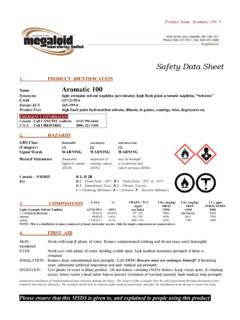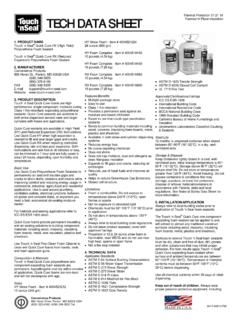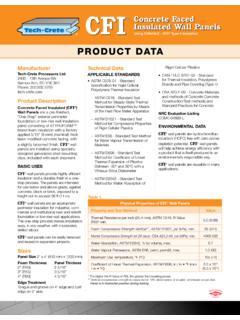Transcription of Safety Data Sheet - Megaloid
1 THIS INFORMATION IS PRESENTED FOR YOUR CONSIDERATION IN THE BELIEF THAT IT IS ACCURATE AND RELIABLE: HOWEVER, NO WARRANTY EITHER EXPRESSED OR IMPLIED IS MADE AND NO FREEDOM FROM LIABILITY FROM PATENTS, TRADEMARKS, OR OTHER LIMITATIONS SHOULD BE INFERRED 1. PRODUCT IDENTIFICATION Name: Mineral Spirits Synonyms: hydrotreated light petroleum distillate; white spirits; stoddart solvent; vanishing oil; aliphatic naphtha CAS# 64742-47-8; alternates: 64742-88-7, 8052-41-3, 64475-85-0 Product Uses: solvent, diluent, fuel Supplier Identifier: Megaloid Laboratories Limited 5515 North Service Road, Suite 306 Burlington, Ontario, Canada L7L 6G4 Phone: 905-337-7411 / Fax: 905-337-1686 EMERGENCY INFORMATION Call CHEMTREC - (800) 424-9300 (CCN# 693764) 2. HAZARDS GHS Class Flammable Eye irritant Skin irritation Aspiration hazard STOT Aquatic hazard (category) (3) (2B) (2) (1) (3) (2) Signal Word DANGER Hazard Statements flammable liquid & vapour (H226) Causes eye irritation (H320) Causes eye irritation (H315) May be fatal if swallowed and enters airways (H304) May cause dizziness or drowsiness (H336) Toxic to aquatic live (H401 Label Pictograms GHS Precautionary Statements for Labelling Prevention P210 Keep away from heat, sparks, open flames and hot surfaces.)
2 No smoking. P240 Ground or bond container and receiving equipment. P241 Use explosion-proof electrical, ventilating and lighting equipment. THIS INFORMATION IS PRESENTED FOR YOUR CONSIDERATION IN THE BELIEF THAT IT IS ACCURATE AND RELIABLE: HOWEVER, NO WARRANTY EITHER EXPRESSED OR IMPLIED IS MADE AND NO FREEDOM FROM LIABILITY FROM PATENTS, TRADEMARKS, OR OTHER LIMITATIONS SHOULD BE INFERRED P242 Use only non-sparking tools. P243 Take precautionary measures against static discharge. P261 Avoid breathing vapours. P271 Use only outdoors or in a well-ventilated area. P273 Avoid release to the environment. P280 Wear eye protection, protective gloves and clothing of butyl rubber Response P301, P310 IF SWALLOWED: immediately call a Poison Center / doctor. P303, P361, P353 IF ON SKIN (or hair): Take off immediately all contaminated clothing. Rinse skin with water or shower. P304, P340 IF INHALED: remove person to fresh air and keep comfortable for breathing. P308, P313 IF exposed or concerned: get medical advice / attention.
3 P312 Call a Poison Center / doctor if you fell unwell. P331 Do not induce vomiting. P370, P378 In care of fire: use water fog, foam, dry chemical or carbon dioxideto extinguish. P391 Collect spillage. Storage P403 + P235 Store in a well-ventilated place. Keep cool. P405 Store locked up. Disposal P501 Dispose of contents and container in accordance with local, regional, national and international regulations. 3. COMPOSITION Chemical Name: CAS No. % Other Identifiers Mineral Spirits 64742-47-8 >99 EC # 265-149-8 4. FIRST AID Inhalation Remove from contaminated area promptly. CAUTION: Rescuer must not endanger himself! If breathing stops, administer artificial respiration and seek medical aid promptly. Skin Contact Wash with plenty of water. Remove contaminated clothing and do not reuse until thoroughly laundered. Eye Contact Wash eyes with plenty of water, holding eyelids open. Seek medical assistance if there is any irritation. Ingestion Give plenty of water to dilute product.
4 Do not induce vomiting (NOTE below). Keep victim quiet. If vomiting occurs, lower victim s head below hips to prevent inhalation of vomited material. Seek medical help promptly. THIS INFORMATION IS PRESENTED FOR YOUR CONSIDERATION IN THE BELIEF THAT IT IS ACCURATE AND RELIABLE: HOWEVER, NO WARRANTY EITHER EXPRESSED OR IMPLIED IS MADE AND NO FREEDOM FROM LIABILITY FROM PATENTS, TRADEMARKS, OR OTHER LIMITATIONS SHOULD BE INFERRED First-aid Comments Inadvertent inhalation of vomited material may seriously damage the lungs. The danger of this is greater than the risk of poisoning through absorption of this relatively low-toxicity substance. The stomach should only be emptied under medical supervision, and after the installation of an airway to protect the lungs. 5. FIRE FIGHTING & FLAMMABILITY Extinguishing Media Suitable Extinguishing Media Foam, dry chemical, water fog, water spray only to cool & dilute, product floats on water - water jet spreads flames Combustion Products Carbon monoxide, nitrogen oxides, smoke, part oxidized hydrocarbon fragments Static Charge Accumulation Readily accumulates a static charge on agitation or pumping; however, the flash point is high enough that this presents little risk except in very hot weather.
5 Special Protective Equipment and Precautions for Fire-fighters Firefighters must wear SCBA. Fire-fighters may enter the area if positive pressure SCBA and full Bunker Gear is worn. 6. ACCIDENTAL RELEASE MEASURES Personal Precautions, Protective Equipment, and Emergency Procedures Evacuate the area immediately. Isolate the hazard area. Keep out unnecessary and unprotected personnel. Eliminate all ignition sources. Use grounded, explosion-proof equipment. Increase ventilation to area or move leaking container to a well-ventilated and secure area. Environmental Precautions Avoid dispersal of spilled material and runoff and contact with soil, waterways, drains and sewers. Inform the relevant authorities if the product has caused environmental pollution (sewers, waterways, soil or air). Water polluting material. May be harmful to the environment if released in large quantities. Collect spillage. Methods and Materials for Containment and Cleaning Up Leak Precaution: dyke to control spillage and prevent environmental contamination Handling Spill: Ventilate contaminated area; recover free liquid with suitable pumps; absorb residue on an inert sorbent, sweep & pick up using plastic or aluminium shovel, & store in closed containers for recycling or disposal.
6 Other Information Report spills to local health, Safety and environmental authorities, as required. 7. HANDLING & STORAGE Precautions for Safe Handling Take care to avoid sparks Non-sparking bronze or aluminum hand tools are recommended required if ambient temperature is above (38oC / 100oF). Electrical & mechanical equipment (lighting, switchgear & forklift trucks) used with or around this product should be explosion-proof. Mineral spirits creates & retains a static charge on agitation or transfer from one container to another. It is prudent to electrically bond the source container, receiving container & pump before transferring contents (applies to transfers of 10 litres or over). Avoid splashing. Keep product nozzle below the surface in the receiving container. Empty containers may contain a flammable vapour. Ensure that containers, empty or full, are tightly sealed unless in use. Never cut, drill, weld or grind THIS INFORMATION IS PRESENTED FOR YOUR CONSIDERATION IN THE BELIEF THAT IT IS ACCURATE AND RELIABLE: HOWEVER, NO WARRANTY EITHER EXPRESSED OR IMPLIED IS MADE AND NO FREEDOM FROM LIABILITY FROM PATENTS, TRADEMARKS, OR OTHER LIMITATIONS SHOULD BE INFERRED on or near this container.
7 Avoid generating or breathing product vapour. If vapour forms, install adequate ventilation. If dealing with a spill & ventilation is impossible or impractical, wear a respirator with an organic vapour cartridge. Avoid prolonged skin contact & wash work clothes frequently. An eye bath & Safety shower must be available near the workplace. NOTE: Absorbent materials soaked in mineral spirits & discarded in a corner may undergo spontaneous combustion. Always allow absorbent materials (rags, sweeping compound, and mops) to dry thoroughly before discarding! Conditions for Safe Storage Store & use in a cool, dry environment, away from sources of ignition & oxidizing agents. 8. EXPOSURE CONTROL & PERSONAL PROTECTION Ontario TWAEV 525mg/m3 Ontario STEV not listed ACGIH TLV 525mg/m3 ACGIH STEL not listed OSHA PEL 1900mg/m3 OSHA STEL not listed Ventilation mechanical ventilation is probably not required, unless product is handled hot Hands nitrile or Viton gloves recommended other types may also protect; consult supplier to confirm suitability Eyes Safety glasses with side shields always protect the eyes Clothing wear impermeable (above) apron, boots, & long sleeves if there is any danger of splashing Appropriate Engineering Controls Use only with adequate ventilation.
8 Use process enclosures, local exhaust ventilation or other engineering controls to keep worker exposure to airborne contaminants below any recommended or statutory limits. The engineering controls also need to keep gas, vapor or dust concentrations below any lower explosive limits. Use explosion-proof ventilation equipment. 9. PHYSICAL PROPERTIES Appearance Clear colourless liquid. Odour kerosene odour Odour threshold ~1ppm pH none (does not liberate hydrogen ions when dissolved) Melting Point/Freezing Point -70oC / -94oF Initial Boiling Point/Range 155-205oC / 310-400oF Flash Point above 38oC / 100oF (closed cup) mineral spirits is specifically formulated to exceed this Evaporation Rate (Butyl Acetate =1) Flammability ( Solid, Gas) Not Available Upper/Lower Flammability or Explosive Limit 6% THIS INFORMATION IS PRESENTED FOR YOUR CONSIDERATION IN THE BELIEF THAT IT IS ACCURATE AND RELIABLE: HOWEVER, NO WARRANTY EITHER EXPRESSED OR IMPLIED IS MADE AND NO FREEDOM FROM LIABILITY FROM PATENTS, TRADEMARKS, OR OTHER LIMITATIONS SHOULD BE INFERRED Vapour Pressure / (20oC / 68oF) Vapour Density (air = 1) 5 Specific Gravity (20/20oC) Water Solubility Nil, also soluble in hydrocarbons and other non-polar solvents.
9 Nearly insoluble in methanol Partition Coefficient, n-Octanol/Water (Log Kow) not known Auto-ignition Temperature 229oC / 444oF Conversion Factor 1ppm = 6mg/m3 (estimated from average molecular weight) Viscosity (25oC / 77oF) Physical State Liquid Molecular Weight 150grams per mole (average mol. wt.) The physical properties of this petroleum distillate may vary. 10. REACTIVITY Dangerously Reactive with strong oxidising agents. Also Reactive with: not known Chemical Stability Stable; will not polymerize Possibility of Hazardous Reactions Under normal conditions of storage and use, hazardous reactions will not occur. Conditions to Avoid Avoid all possible sources of ignition (spark or flame). Do not pressurize, cut, weld, braze, solder, drill, grind or expose containers to heat or sources of ignition. Do not allow vapour to accumulate in low or confined areas. Do not store with strong oxidizing agents. Mechanical Impact Not sensitive 11. TOXICITY Acute Toxicity LD50 (oral) >5000mg/kg (rat) in 11 reports with kerosene or jet fuel no mortality reported LD50 (skin) 2000-15,400mg/kg (rabbit); >2000mg/kg (rabbit) in 11 reports with kerosene or jet fuel no mortality reported LC50 (inhalation) 3400-8000ppm (rat); >4300 >7500mg/m3 (rat, 9 reports), >6400mg/m3 (cat) no mortality in these studies Skin Corrosion/Irritation not irritating in three 4-hour & three 24-hour tests; irritating in seven 24-hour tests Serious Eye Damage/Irritation 11 rabbit tests rated this type of hydrocarbon as not irritating , but two of these suggested a slight effect, some reports suggest that vapour above 150ppm maybe irritating.
10 THIS INFORMATION IS PRESENTED FOR YOUR CONSIDERATION IN THE BELIEF THAT IT IS ACCURATE AND RELIABLE: HOWEVER, NO WARRANTY EITHER EXPRESSED OR IMPLIED IS MADE AND NO FREEDOM FROM LIABILITY FROM PATENTS, TRADEMARKS, OR OTHER LIMITATIONS SHOULD BE INFERRED STOT (Specific Target Organ Toxicity) - Single Exposure Inhalation vapour above 400ppm may cause burning sensation in nose & throat, intoxication dizziness, fatigue. Skin Absorption slight; no toxic effects by this route. Ingestion may cause diarrhoea & stomach discomfort not a route of industrial exposure. STOT (Specific Target Organ Toxicity) - Repeated Exposure Prolonged or repeated contact may cause dermatitis & skin cracking; chronic exposure to vapour may cause tingling, numbness, memory loss. Respiratory and/or Skin Sensitization Not known to be a respiratory sensitizer. Carcinogenicity Some jet fuel or kerosene hydrocarbons were weakly carcinogenic in mice applied 3-6 times a week for 1-2 years; hydrotreated kerosene-type hydrocarbons (many solvents) tend not to be carcinogenic.






